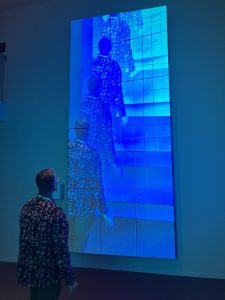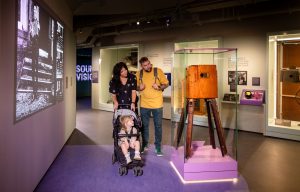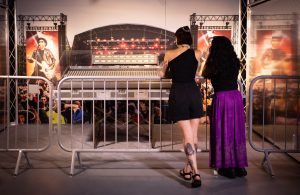A new gallery documenting the history of film, television and media opens its doors in the heart of Bradford tomorrow, and has been described as a new “cultural gem” for the city.
The Sound and Vision Gallery at the National Science and Media Museum includes priceless artefacts including the camera that captured the first moving image, the fangs worn by Christopher Lee in the Hammer Dracula movies and Stooky Bill – the dummy head that was the subject of the first television broadcast.
The permanent gallery is the latest part of the museum’s £6.8m refurbishment, and opens on the same day as another major city centre regeneration project – Darley Street Market.
Both venues will be celebrating the openings with family events this weekend that are expected to attract huge crowds.

Sound and Vision gives a spotlight to many artefacts that have spent years in the museum’s storage, including a model dinosaur created by stop motion maestro Ray Harryhausen and a replica of the original xenomorph costume used in the first Alien film.
There is also an area dedicated to the Cottingley Faries photos – which includes one of the original cameras used to take what became one of the most well-known hoaxes in history and which originated in a village just a few miles from the museum.
It is hoped that the gallery will cement the museum’s reputation as a national attraction.
The refurbishment works have been supported by the National Lottery Heritage Fund.
As well as more than 500 historic artefacts, there are a number of interactive areas and newly created installations.
The Local Democracy Reporting Service was given a tour of the gallery on Wednesday ahead of today’s launch.
At the centre of Sound and Vision is ‘Circus’ a new art installation by Nayan Kulkarni that uses a series of cameras and screens to create a digital hall of mirrors.
People standing inside the installation can see their image distorted in a variety of different ways.
Other installations allow visitors to be part of a Cottingley Fairy photo and become a sound engineer for a concert at Bradford’s famous 1 in 12 Club.
The first IMAX camera has been returned to the museum and the hulking piece of equipment is one of the first exhibits in the gallery – reflecting the importance of IMAX to the history of the museum.
In 1983 the museum opened the first IMAX cinema in the UK, with this camera used to project ‘To Fly’ – a documentary about the history of flight.

Image: Jason Lock
Other cameras in the exhibition include Louis Le Prince’s single lens cine camera – which captured the world’s first moving film footage in Leeds, and the camera used by Herbert Ponting to document Captain Scott’s Antarctic Expedition in 1910.
John Logie Baird’s groundbreaking experimental ‘television apparatus’ from 1926, which includes the Stookie Bill head that was the first image to be broadcast, is another hugely significant artefact in the gallery.
The fast-moving pace of technology means that it some of the exhibits, such as an iPod and television digibox, are not that far removed from the lives of many of the people who will visit the exhibition.
Other exhibits include a Dalek from Doctor Who, a mixing desk used at festivals and Shaun the Sheep models from Aardman Animation.

Yvonne Carmichael, project manager for Sound and Vision, said the refurbishment works have seen many areas of the museum opened up, creating much more space.
She said: “A lot of the items in this gallery were buried away or not very visible before, we’ve brought a lot out, things like the Cottingley Faries artefacts.
“We hope this is something that people will travel to see.”
Toni Booth, curator of film, said: “One of the main focuses was to showcase more of the museum’s collection, and the gallery was partly led by the objects we had.
“We’ve increased the number of objects we have on display three-fold compared to before. The vast majority of them were in our museum collection already, and it is great we’ve got so much space now.
“We’ve got around three and a half million objects in our collection, so it is always a struggle to decide what to display.”
Jo Quinton-Tulloch, director of the National Science and Media Museum, said: “The galleries have been a true labour of love and collaboration, and they showcase our incredible collections in new and innovative ways.
“Our collections and the rich narratives they tell touch upon all our lives, from the first photographic negative and film footage to the advent of radio and television, and the power of sound technologies to bring us together.
“We have worked closely with a huge range of people to develop the galleries, ensuring these spaces work for everyone and that our visitors feel represented in the stories we tell.”
Helen Featherstone, director, England, north at The National Lottery Heritage Fund added: “The Sound and Vision galleries at the National Science and Media Museum are a cultural gem for the city, telling the story behind the photographic, film and sound technologies that have played such a big role in our lives.”




